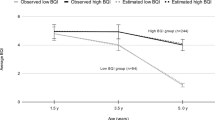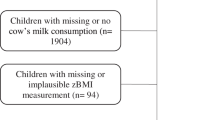Abstract
Background/Objectives:
Evidence supporting the association between skipping breakfast and children’s body mass index (BMI) has been widely reported, and some consideration has been given to children aged 2–5 years. However, no evidence has considered an association between children skipping breakfast and mother's BMI. This study therefore investigated associations between skipping breakfast, child's BMI and mother's BMI in a large cohort of Australian children.
Subjects/Methods:
Data were drawn from wave 2 (2–3 years, n=4601) and wave 3 (4–5 years, n=4381) of the Longitudinal Study of Australian Children. The primary outcome was skipping breakfast. Child's and mother's BMI was assessed by trained professionals.
Results:
Girls at 4–5 years were significantly more likely to skip breakfast compared with boys (56.9% versus 43.1%; P=0.031). In cross-sectional data analysis, obese boys at 2–3 years (odds ratio (OR) 2.38; P=0.039) and at 4–5 years (OR 2.32; P=0.046), and also obese girls at 4–5 years (OR 2.26; P=0.018), were more likely to skip breakfast. Skipping breakfast was positively associated with boys at 2–3 years (OR 2.04; P=0.042) whose mothers were overweight and with girls at 4–5 years (OR 2.60; P=0.001) whose mothers were obese. In longitudinal cross-lagged analysis, boys at 2–3 years whose mothers were obese were more likely to skip breakfast 2 years later at age 4–5 years (OR 2.36; P=0.045).
Conclusions:
Skipping breakfast was associated with higher BMI in children and mothers. Future interventions should target obese mothers to promote breakfast intake among children. The interventions may involve changes to dietary and lifestyle habits and provision of education on the benefits of breakfast intake.
This is a preview of subscription content, access via your institution
Access options
Subscribe to this journal
Receive 12 print issues and online access
$259.00 per year
only $21.58 per issue
Buy this article
- Purchase on Springer Link
- Instant access to full article PDF
Prices may be subject to local taxes which are calculated during checkout
Similar content being viewed by others
References
Rampersaud GC . Benefits of breakfast for children and adolescents: update and recommendations for practitioners. Am J Lifestyle Med 2009; 3: 86–103.
Affenito SG, Thompson D, Dorazio A, Albertson AM, Loew A, Holschuh NM . Ready-to-eat cereal consumption and the School Breakfast Program: relationship to nutrient intake and weight. J Sch Health 2013; 83: 28–35.
Ask AS, Hernes S, Aarek I, Johannessen G, Haugen M . Changes in dietary pattern in 15 year old adolescents following a 4 month dietary intervention with school breakfast—a pilot study. Nutr J 2006; 5: 33.
Utter J, Scragg R, Schaaf D, Fitzgerald E, Wilson N . Correlates of body mass index among a nationally representative sample of New Zealand children. Int J Pediatr Obes 2007; 2: 104–113.
Willimas P . Breakfast and the diets of Australian children and adolescents: an analysis of data from the 1995 National Nutrition Survey. Int J Food Sci Nutr 2007; 58: 201–216.
Dubois L, Girard M, Potvin Kent M, Farmer A, Tatone-Tokuda F . Breakfast skipping is associated with differences in meal patterns, macronutrient intakes and overweight among pre-school children. Public Health Nutr 2009; 12: 19–28.
Rampersaud GC, Pereira MA, Girard BL, Adams J, Metzl JD . Breakfast habits, nutritional status, body weight, and academic performance in children and adolescents. J Am Diet Assoc 2005; 105: 743–760.
Delva J, Omalley PM, Johnston LD . Racial/ethnic and socioeconomic status differences in overweight and health-related behaviors among American students: National trends 1986–2003. J Adolesc Health 2006; 39: 536–545.
Sweeney NM, Horishita N . The breakfast-eating habits of inner city high school students. J School Nurs 2005; 21: 100–105.
Radcliffe B, Ogden C, Welsh J, Carroll S, Coyne T, Craig P . The Queensland school breakfast project: a health promoting schools approach. Nutr Diet 2005; 62: 33–40.
Zapata LB, Bryant CA, McDermott RJ, Hefelfinger JA . Dietary and physical activity behaviors of middle school youth: the youth physical activity and nutrition survey. J School Health 2008; 78: 9–18.
Timlin MT, Pereira MA, Story M, Neumark-Sztainer D . Breakfast eating and weight change in a 5-year prospective analysis of adolescents: Project EAT (Eating Among Teens). Pediatrics 2008; 121: e638–e645.
Raaijmakers LG, Bessems KM, Kremers SP, Van Assema P . Breakfast consumption among children and adolescents in the Netherlands. Eur J Public Health 2010; 20: 318–324.
Vereecken C, Dupuy M, Rasmussen M, Kelly C, Nansel TR, Al Sabbah H et al, HBSC Eating & Dieting Focus Group.. Breakfast consumption and its socio-demographic and lifestyle correlates in schoolchildren in 41 countries participating in the HBSC study. Int J Public Health 2009; 54: 180–190.
Utter J, Scragg R, Mhurchu CN, Schaaf D . At-home breakfast consumption among New Zealand children: associations with body mass index and related nutrition behaviours. J Am Diet Assoc 2007; 107: 570–576.
Albertson AM, Franko DL, Thompson D, Eldridge AL, Holschuh N, Affenito SG et al. Longitudinal patterns of reakfast eating in Black and White adolescent girls & ast. Obesity 2007; 15: 2282–2292.
Vanhala M, Korpelainen R, Tapanainen P, Kaikkonen K, Kaikkonen H, Saukkonen T et al. Lifestyle risk factors for obesity in 7-year-old children. Obes Res Clin Pract 2009; 3: I–II.
Macfarlane A, Cleland V, Crawford D, Campbell K, Timperio A . Longitudinal examination of the family food environment and weight status among children. Int J Pediatr Obes 2009; 4: 343–352.
Thompson-Mccormick JJ, Thomas JJ, Bainivualiku A, Khan AN, Becker AE . Breakfast skipping as a risk correlate of overweight and obesity in school-going ethnic Fijian adolescent girls. Asia Pac J Clin Nutr 2010; 19: 372–382.
Deshmuku-Taskar PR, Nicklas TA, O'Neil CE, Keast DR, Radcliffe JD, Cho S . The relationship of breakfast skipping and type of breakfast consumption with nutrient intake and weight status in children and adolescents: The National Health and Nutrition Examination Survey 1999–2006. J Am Diet Assoc 2010; 110: 869–878.
Isacco L, Lazaar N, Ratel S, Thivel D, Aucouturier J, Doré E et al. The impact of eating habits on anthropometric characteristics in French primary school children. Child Care Health Dev 2010; 36: 835–842.
Antonogeorgos G, Panagiotakos DB, Papadimitriou A, Priftis KN, Anthracopoulos M, Nicolaidou P . Breakfast consumption and meal frequency interaction with childhood obesity. Pediatr Obes 2011; 7: 65–72.
Tin SP, Ho SY, Mak KH, Wan KL, Lam TH . Location of breakfast consumption predicts body mass index change in young Hong Kong children. Int J Obes 2012; 36: 925–930.
Januszek-Trzciąkowska A, Małecka-Tendera E, Klimek K, Matusik P . Obesity risk factors in a representative group of Polish prepubertal children. Arch Med Sci 2014; 10: 880–885.
Dubois L, Girard M, Kent MP . Breakfast eating and overweight in a pre-school population: is there a link? Public Health Nutr 2006; 9: 436–442.
Küpers LK, de Pijper JJ, Sauer PJJ, Stolk RP, Corpeleijn E . Skipping breakfast and overweight in 2- and 5-year-old Dutch children—the GECKO Drenthe cohort. Int J Obesity 2014; 38: 569–571.
Johannsen DL, Johannsen NM, Specker BL . Influence of parents eating behaviors and child feeding practices on childrens weight status. Obesity 2006; 14: 431–439.
Thibault H, Contrand B, Saubusse E, Baine M, Maurice-Tison S . Risk factors for overweight and obesity in French adolescents: physical activity, sedentary behavior and parental characteristics. Nutrition 2010; 26: 192–200.
Sekine M, Yamagami T, Saito T, Nanri S, Kawaminami K, Tokui N et al. Characteristic lifestyles in 6-year-old children with obese parents: Results of the Toyama birth cohort study. Enviro Health Prev Med 2001; 6: 104–108.
Soloff C, Lawrence D, Johnstone R . The Longitudinal Study of Australian Children: An Australian Government initiative, LSAC Technical Paper No. 1. Sample Design, ISSN 1832-9918. Australian Institute of Family Studies: Melbourne, VIC, Australia, 2005, pp 1–30.
Soloff C, Lawrence D, Misson S, Johnstone R . Wave 1 Weighting and Non-Response, The Longitudinal Study of Australian Children: An Australian Government Initiative, LSAC Technical Paper No. 3. Australian Institute of Family Studies: Melbourne, VIC, Australia, 2006, pp 1–50.
Mission S, Sipthorp M. LSAC Technical Paper No. 5: Wave 2 weighting and non-response. Discussion paper, Australian Institute of Family Studies, 2007.
Sipthorp M, Misson S . Wave 3 Weighting and Non-Response, The Longitudinal Study of Australian Children, LSAC Technical Paper No. 6. Australian Institute of Family Studies: Melbourne, VIC, Australia, 2009.
Australian Institute of Family Studies. Data User Guide. The Longitudinal Study of Australian Children: An Australian Government Initiative. Australian Institute of Family Studies: Melbourne, VIC, Australia, 2009.
Cole TJ, Bellizzi MC, Flegal KM, Dietz WH . Establishing a standard definition for child overweight and obesity worldwide. International survey. BMJ 2000; 320: 1240–1243.
Cole TJ, Flegal KM, Nicholls D, Jackson AA . Body mass index cut offs to define thinness in children and adolescents: International survey. BMJ 2007; 335: 194–197.
Kutner MH, Nachtsheim CJ, Neter J . Applied Linear Statistical Models. McGraw-Hill Irwin: New York, NY, USA, 2005.
Mackinnon DP, Fairchild AJ, Fritz MS . Mediation analysis. Annu Rev Psychol 2007; 58: 593–614.
Australian Bureau of Statistics (ABS). National Nutrition Survey Selected Highlights Australia 1995 (ABS cat. no. 4802.0). Australian Bureau of Statistics: Canberra, ACT, Australia, 1997.
Shaw ME . Adolescent breakfast skipping: an Australian study. Adolescence 1998; 33: 851–861.
AlBshtawy M . Exploring the reasons why school students eat or skip breakfast. Nurs Child Young People 2015; 27: 16–22.
O'Dea JA, Wagstaff S . Increased breakfast frequency and nutritional quality among schoolchildren after a national breakfast promotion campaign in Australia between 2000 and 2006. Health Educ Res 2011; 26: 1086–1096.
Berg C, Lappas G, Wolk A, Strandhagen E, Toraen K, Rosengren A et al. Eating patterns and portion size associated with obesity in a Swedish population. Appetite 2009; 52: 21–26.
Ahadi Z, Qorbani M, Kelishadi R, Ardalan G, Motlagh ME, Asayesh H et al. Association between breakfast intake with anthropometric measurements, blood pressure and food consumption behaviors among Iranian children and adolescents: the CASPIAN-IV study. Public Health 2015; 129: 740–747.
Mirza NM, Klein CJ, Palmer MG, Mccarter R, He J, Ebbeling CB et al. Effects of high and low glycemic load meals on energy intake, satiety and hunger in obese Hispanic American youth. Int J Pediatr Obes 2011; 6: e523–e531.
Fuemmeler BF, Stroo M, Lee CT, Bazemore S, Blocker B, Østbye T . Racial differences in obesity-related risk factors between 2-year-old children born of overweight mothers. J Pediatr Psychol 2015; 40: 649–656.
Hallström L, Vereecken CA, Ruiz JR, Patterson E, Gilbert CC, Catasta G et al. Breakfast habits and factors influencing food choices at breakfast in relation to socio-demographic and family factors among European adolescents. The HELENA Study. Appetite 2011; 56: 649–657.
Rangan A, Gill T, Webb K . Short questions for surveys about bread and cereal intake: comparing measures of quantity versus frequency. NSW Public Health Bull 2006; 17: 39–43.
Australian Bureau of Statistics (ABS). AusStats 6523.0 Household Income and Income Distribution, Australia 2003–04 (Appendix 3). Australian Bureau of Statistics: Canberra, ACT, Australia, 2005.
Commonwealth of Australia. Australian Standard Classification of Occupations, 2nd edn (ABS cat. no. 1220.0), ISBN 0 64223200 8. Commonwealth of Australia: Canberra, ACT, Australia, 1997.
Acknowledgements
This research received no specific grant from any funding agency, commercial or not-for-profit sectors.
Author contributions
NA conceived the idea for this study, conducted the statistical analysis, interpretation of the results, writing and took a lead role in developing the manuscript. SS provided guidance on writing, assistance in interpreting the data and critically reviewed the paper. All authors read the final manuscript and approved the contents.
Author information
Authors and Affiliations
Corresponding author
Ethics declarations
Competing interests
The authors declare no conflict of interest.
Rights and permissions
About this article
Cite this article
Alsharairi, N., Somerset, S. Skipping breakfast in early childhood and its associations with maternal and child BMI: a study of 2–5-year-old Australian children. Eur J Clin Nutr 70, 450–455 (2016). https://doi.org/10.1038/ejcn.2015.184
Received:
Revised:
Accepted:
Published:
Issue Date:
DOI: https://doi.org/10.1038/ejcn.2015.184
This article is cited by
-
Describing the longitudinal breakfast quality index trajectories in early childhood: results from Melbourne InFANT program
European Journal of Clinical Nutrition (2023)
-
Skipping breakfast is associated with adiposity markers especially when sleep time is adequate in adolescents
Scientific Reports (2019)



